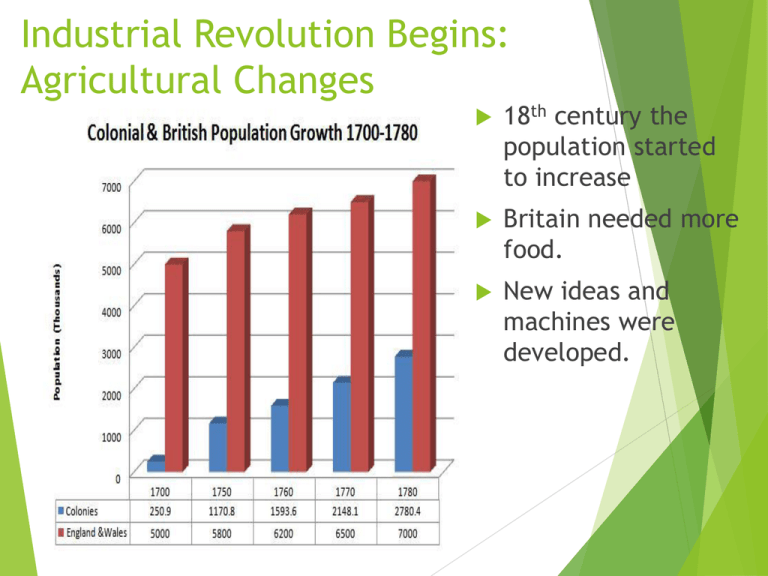Samuel Slater 1768-1835 is known as the Father of the American Industrial Revolution because he brought British textile technology to the United States. In turn the cotton industry became more profitable and it made more money for the textile industry.

The Agricultural Revolution Ppt Video Online Download
More people wanted to start businesses and build factories.

. 1770 Hargreaves patented the Spinning Jenny. Samuel Slater and Mills. The textile industry refers to the business of creating buying and selling clothing and.
The British textile industry drove the Industrial Revolution triggering advancements in technology stimulating the coal and iron industries boosting raw material imports and improving transportation which made Britain the global leader of industrialization trade and. However cotton was a more versatile fabric and during the Industrial Revolution cotton rose dramatically in importance leading some historians to argue that the developments spurred by this burgeoning industry technology trade transport stimulated the whole revolution. TEXTILE INDUSTRY TEXTILE INDUSTRY.
The raw materials were harder to come by the cotton was cheaper and the cotton industry was able to make more money with less raw materials. The movement dealt with changes in technology that increased business and made the lives. Agriculture during the first industrial revolution.
Among the notable inventions during. How did the textile industry profit from the agricultural revolution. The textile industry was based on the development of cloth and clothing.
The textile industry was second in economical importance the first being agriculture. In the 18 th and 19 th centuries people started to move away from farms and into cities where new types of employment were becoming available. Historians refer to this method of production as the cottage industry.
The first industrial revolution helped us move from an agrarian society to one where more tasks were mechanized. A better type of cotton was invented. The demand for cloth grew so merchants had to compete with others for the supplies to make it.
1764 Spinning jenny invented by James Hargreaves. As Great Britain reaped the benefits of the industrial revolution. 1769 Arkwright patented the water frame.
How did the textile industry profit from the agricultural revolution. The solution was to use machinery which was cheaper then products made by hand which took a long time to create therefore. One of the main industries that benefitted from the Industrial Revolution was the textile industry.
How did the textile industry profit from the agricultural revolution. 1742 Cotton mills were first opened in England. Clothing and Textiles in the Industrial Revolution.
Before the start of the Industrial Revolution which began in the 1700s the production of goods was done on a very small scale. - A better type of cotton was invented. The Industrial Revolution is a movement that began in the 18 th Century in England and rapidly spread throughout the rest of Europe and North America.
- It profited from the invention of the steel plow. The Agricultural Revolution was a period of time in Europe that lasted from the 1700s to the early 1800s. Between 1450 and 1800 textile production was second only to agriculture in economic importance.
Submitted by sherylperkins on July 2 2013 - 347pm. It employed more people and produced more profit than any other manufactured product. How did the technological advances in the textile industry contribute to an industrial Revolution in great Britain.
Production and trade existed at. It profited from the invention of the steel plow. After the revolution it gave opportunities for workers to.
Bringing British technology to the US. To forestall economic difficulties which could foster the rise of communism throughout Europe. This raised a problem for the consumer because the products were at a higher cost.
Before the revolution the manufacture of cloth was done on the premises of where the workers lived. - Costs were decreased. 6 The Agricultural Revolution helped bring about the Industrial Revolution through innovations and inventions that altered how the farming process worked.
Because of the difficulty of agricultural work it became necessary to innovate the agricultural industry thus beginning the Agricultural Revolution which arguably started in the mid-18 th century. It tried to keep English mehtods and incentions to itself. How did the Agricultural Revolution contribute to an industrial Revolution in great Britain.
Other historians have argued that cotton production wasnt any more important. The textile industry significantly grew during the Industrial Revolution. The textile industry suffered from the agricultural revolution as well.
The first powered textile machine. The textile industry was founded by the work and importance of the following businessmen inventors and inventions. The first machine to improve upon the spinning wheel.
Samuel Slater has been called both the Father of American Industry and the Founder of the American Industrial Revolution Slater built several successful cotton mills in New England and established. 1764 Water frame invented by Richard Arkwright.
Effects Of Agriculture On The Industrial Revolution Foundations Of Western Culture

Industrial Revolution Begins Agricultural Changes

Agricultural Revolution 1650 1800 Agricultural Revolution Ap Human Geography History Of Agriculture
_CNE-v1-p58-H.jpg)
Effects Of Agriculture On The Industrial Revolution Foundations Of Western Culture
0 Comments